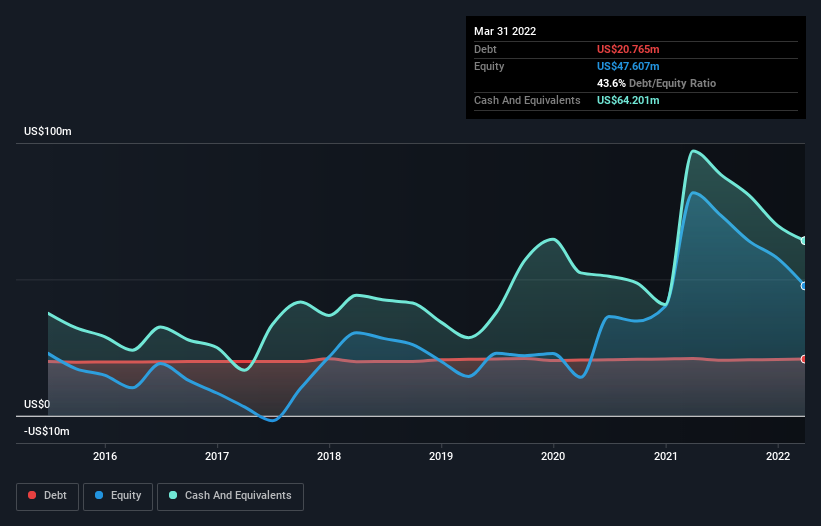
Legendary fund manager Li Lu (who Charlie Munger backed) once said, 'The biggest investment risk is not the volatility of prices, but whether you will suffer a permanent loss of capital.' So it might be obvious that you need to consider debt, when you think about how risky any given stock is, because too much debt can sink a company. We can see that DURECT Corporation (NASDAQ:DRRX) does use debt in its business. But the real question is whether this debt is making the company risky.
When Is Debt A Problem?
Debt and other liabilities become risky for a business when it cannot easily fulfill those obligations, either with free cash flow or by raising capital at an attractive price. If things get really bad, the lenders can take control of the business. However, a more frequent (but still costly) occurrence is where a company must issue shares at bargain-basement prices, permanently diluting shareholders, just to shore up its balance sheet. Of course, debt can be an important tool in businesses, particularly capital heavy businesses. When we think about a company's use of debt, we first look at cash and debt together.
See our latest analysis for DURECT
What Is DURECT's Net Debt?
The chart below, which you can click on for greater detail, shows that DURECT had US$20.8m in debt in March 2022; about the same as the year before. But on the other hand it also has US$64.2m in cash, leading to a US$43.4m net cash position.

How Strong Is DURECT's Balance Sheet?
The latest balance sheet data shows that DURECT had liabilities of US$9.02m due within a year, and liabilities of US$23.9m falling due after that. Offsetting these obligations, it had cash of US$64.2m as well as receivables valued at US$960.0k due within 12 months. So it actually has US$32.2m more liquid assets than total liabilities.
This luscious liquidity implies that DURECT's balance sheet is sturdy like a giant sequoia tree. Having regard to this fact, we think its balance sheet is as strong as an ox. Succinctly put, DURECT boasts net cash, so it's fair to say it does not have a heavy debt load! When analysing debt levels, the balance sheet is the obvious place to start. But it is future earnings, more than anything, that will determine DURECT's ability to maintain a healthy balance sheet going forward. So if you want to see what the professionals think, you might find this free report on analyst profit forecasts to be interesting.
In the last year DURECT had a loss before interest and tax, and actually shrunk its revenue by 55%, to US$14m. To be frank that doesn't bode well.
So How Risky Is DURECT?
We have no doubt that loss making companies are, in general, riskier than profitable ones. And in the last year DURECT had an earnings before interest and tax (EBIT) loss, truth be told. Indeed, in that time it burnt through US$32m of cash and made a loss of US$37m. Given it only has net cash of US$43.4m, the company may need to raise more capital if it doesn't reach break-even soon. Overall, its balance sheet doesn't seem overly risky, at the moment, but we're always cautious until we see the positive free cash flow. The balance sheet is clearly the area to focus on when you are analysing debt. However, not all investment risk resides within the balance sheet - far from it. These risks can be hard to spot. Every company has them, and we've spotted 2 warning signs for DURECT you should know about.
When all is said and done, sometimes its easier to focus on companies that don't even need debt. Readers can access a list of growth stocks with zero net debt 100% free, right now.
New: Manage All Your Stock Portfolios in One Place
We've created the ultimate portfolio companion for stock investors, and it's free.
• Connect an unlimited number of Portfolios and see your total in one currency
• Be alerted to new Warning Signs or Risks via email or mobile
• Track the Fair Value of your stocks
Have feedback on this article? Concerned about the content? Get in touch with us directly. Alternatively, email editorial-team (at) simplywallst.com.
This article by Simply Wall St is general in nature. We provide commentary based on historical data and analyst forecasts only using an unbiased methodology and our articles are not intended to be financial advice. It does not constitute a recommendation to buy or sell any stock, and does not take account of your objectives, or your financial situation. We aim to bring you long-term focused analysis driven by fundamental data. Note that our analysis may not factor in the latest price-sensitive company announcements or qualitative material. Simply Wall St has no position in any stocks mentioned.
About NasdaqCM:DRRX
DURECT
A biopharmaceutical company, develops medicines based on its epigenetic regulator program.
High growth potential low.
Similar Companies
Market Insights
Community Narratives




